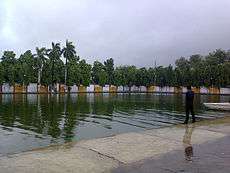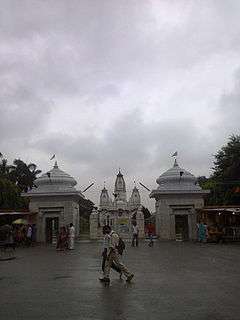Gorakhnath Math
| Gorakhnath Mandir | |
|---|---|
|
Gateway to the temple | |
| Name | |
| Other names | Gorakhnath Mutt |
| Proper name | Gorakshanath Mandir |
| Devanagari | गोरखनाथ मंदिर |
| Geography | |
| Country | India |
| State | Uttar Pradesh |
| District | Gorakhpur |
| Culture | |
| Primary deity | Gorakshanath(Shiva) |
| Important festivals | Makar Sakranti |
| Architecture | |
| Architectural styles | Mandir |
| History and governance | |
| Date built | unknown |
| Website | gorakhnathmandir.in |

The Gorakhnath Nath (Gorakhnath Mutt) is a temple of the Nath monastic group in the Nath tradition. The name Gorakhnath derives from the medieval saint, Gorakhnath (c. 11th century), a famous yogi who travelled widely across India and authored a number of texts that form part of the canon of the Nath sampradaya. The Nath tradition was founded by guru Matsyendranath.This math is situated in Gorakhpur, Uttar Pradesh within a large premises.The temple performs various cultural and social activities and serves as the cultural hub of the city.
History
The Gorakhpur district takes its name from Gorakhnath, who was a saint of the 'Nath Sampradaya'. A famous shrine called Gorakhnath Nath was built in his honour at the location where he practised his austerities.
The Gorakhpur region comprises the districts of Kushinagar, Basti, Deoria, Azamgarh and parts of Nepal tarai. These areas, which may be called the Gorakhpur janapad, were an important centre of the Hindu Vedic culture.
Gorakhpur was a part of the famous kingdom of Koshal, one of the sixteen mahajanapadas in the 6th century BC. The earliest known monarch ruling over this region with his capital at Ayodhya was Ikshavaku, who founded the solar dynasty of kshatriyas. It produced a number of illustrious kings till the accession of Ram, who was the greatest ruler of this dynasty. Since then, Gorakhpur remained an integral part of the erstwhile empires of Maurya, Shunga, Kushana, Gupta and Harsha dynasties.
Religious activity
Today's Gorakhnath Math, centred at Gorakhpur in eastern Uttar Pradesh (also named after the saint), is a religious institution that runs two Gorakhnath temples, one in Nepal in the district of Gorkha (another word believed to be derived from Baba Gorakhnath), and the other a little south of Gorakhpur. The temple at Gorakhpur is said to contain the samadhi shrine (tomb) and gaddi (prayer seat) of Gorakhnath. These temples constitute the centre of most of the Hindu religious activity in this region.
Thousands of devotees come to these temples on the occasion of Makar Sankranti, when they offer khichdi to Gorakhnath Baba. The King of Nepal also occasionally visits one of these temples during this festival.
The Gorakhnath Math has a significant following in eastern Uttar Pradesh and the Terai regions of Nepal, and also among wider circles across the Nath groups. The monastic order, according to the principles of saint Gorakhnath, does not follow caste conventions as other Hindu religious groups do. Thus, non-Brahmins may serve as priests.
The present Mahant or Chief Priest is Yogi Adityanath. He was appointed Mahant on 14-September-2014. He was preceded by his guru, Mahant Avaidyanath, who died on 12 September 2014, and was given samadhi beside that of his guru Digvijay Nath in the Gorakhnath Temple.
It is widely believed that those who chant Shri Gorakhnath Chalisa 12 times are blessed with a miracle jyoti (auspicious flame).

Political activity
The Gorakhnath Math has been involved in political matters for more than half a century. Mahant Digvijay Nath joined the Congress in 1921 and was arrested for taking an "active part" in the Chauri Chaura incident, thereby putting a brake on Gandhi's non-cooperation movement. He joined the Hindu Mahasabha in 1937 and soon became the head of the party's unit in United Provinces. He strongly opposed Gandhi's non-violent movement. Shortly after independence, he was arrested for inflaming passions against Gandhi that led to his assassination and imprisoned for 9 months. After release, he spearheaded the Ram Janmabhoomi movement of 1949, organising a 9-day long recitation of Ramcharit Manas, at the end of which the idols of Rama and Sita were placed inside the Babri Masjid. The Babri Masjid was locked down as a result, but it led to Digvijay Nath's rise in the Hindu Mahasabha. He was appointed the General Secretary at the national level and won the election for the MP of Gorakhpur in 1967.[1]
His successor, Mahant Avaidyanath got elected as an MLA for Maniram as an independent in 1962, 1967, 1969, 1974 and 1977 and also as an MP from Gorakhpur in 1970 and 1989. Soon after the Sangh Parivar started its own Ram Janmabhoomi movement, he joined the Bharatiya Janata Party (BJP) and got elected as MP of Gorakhpur on a BJP ticket in 1991 and 1996.[1]
Yogi Adityanath has also been active in the Bharatiya Janata Party (BJP), and has moulded the Hindutva forces in the region by a combination of alliances cutting across caste lines, and by raising demands for better economic livelihood.[2] Adityanath has been the MP from Gorakhpur since 1998, and has emerged as a major power center in Uttar Pradesh. He founded the Hindu Yuva Vahini (Hindu Youth Force).[3] The group has also been involved in much communal activity, including the Mau riots[4] of October 2005 and the Gorakhpur riots[3] of January 2007. In the General elections of 2007, the Hindu Yuva Vahini was at one point contemplating running for the elections on its own under the Hindu Mahasabha banner,[5] but finally reached a compromise with the BJP.
In May 2015, the math organized special havans and kalash-yatra to pray for the victims of 2015 India-Nepal Earthquakes which killed close to 1000 people.[6]
External links
References
- 1 2 Jaffrelot, Christophe (6 October 2014). "The other saffron". Indian Express. Retrieved 2014-10-06.
- ↑ Subhash Gatade (2004-10-07). "Hindutvaisation of a Gorakhnath Mutt: the Yogi and the Fanatic". South Asia Citizen's Web. Retrieved 2007-05-01.
- 1 2 Apoorvanand (2007-02-17). "Riot, manufactured in Gorakhpur". Tehelka. Retrieved 2007-04-26.
- ↑ Asghar Ali Engineer (February 1–15, 2006). "COMMUNAL RIOTS - 2005 (Part II): Major Riot in Mau (U.P.)".
- ↑ Atiq Khan (2007-03-28). "Yogi's revolt may hit BJP: Ex-BJP leader to go it alone in U.P". The Hindu. Retrieved 2007-04-26.
- ↑ "Gorakhnath Mutt temple holds havans and Kalashytra for 2015 Earthquake victims". news.biharprabha.com. ANI. 22 May 2015. Retrieved 22 May 2015.
